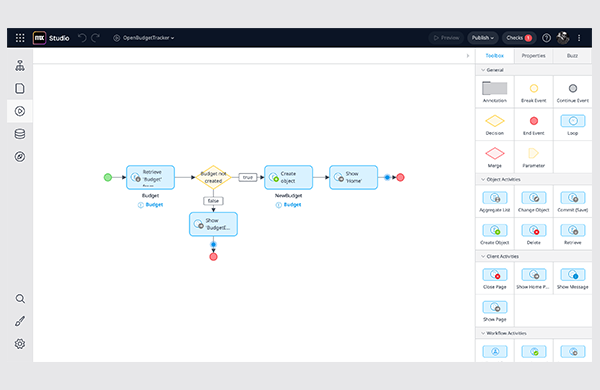AuraQ has vast experience helping organisations find the gaps that can be filled to enhance their business. This could be to improve efficiency, integrate legacy systems or deliver new portals and strategic applications to create competitive advantage. Contact us to request a free, no obligation Gap Analysis.
The low-code revolution!
I’ve worked in roles sat between developers and clients for the best part of 25 years. In this time, I’ve experienced the vast frustrations felt on both sides of the fence when both developing and /or buying software. These aren’t segregated issues; they flow both ways and I can empathise with both. Developers are affected by client’s frustrations, dissatisfaction and changing demands, and clients can certainly suffer as a result of lengthy development cycles, or limitations when buying software and off-the-shelf solutions. It has always been an all-encompassing issue. Generally speaking, clients (the business) have typically had two choices; build it themselves (either internally or by engaging with an external development team) or buy “off-the-shelf”. If it’s the build route, professional developers typically then have had one choice – hard coding applications. The language or programmes used vary but ultimately the ‘norm’ would be some form of custom coding.
So, to build or not to build? In this blog, I’ll share my experience from both sides and then introduce low-code – a revolutionised way of doing things that benefits both the business and IT and delivers true collaboration!
Build It
For developers, coding a bespoke application using traditional development methods is a time-consuming process. Ultimately, this means that it is usually an expensive option and can result in inflexible and restrictive solutions. Because of long development cycles, solutions often cannot be deployed early to gain competitive advantage or deliver benefit quickly – often pushing the cost break-even point well into the future.
Accompanying high costs and long timeframes, it’s also frustrating for business owners and stakeholders as there is little (or in many cases, no) visibility until release. Often the business requirement has changed well before the initial release is anywhere near ready. At which point it becomes clear that the vision and the development have gone at tangents to each other leading to further costs and delay. Whilst historically coding bespoke applications has been the only choice for organisations with niche or unique processes, it isn’t the ideal solution for many.
Buy It
“Off-the-shelf” systems are great if you have a common and entirely prescribed process, but what if what you do is different, or your processes vary over time, and you need to adapt and alter them? Habitually, organisations have bought off-the-shelf solutions as the closest fit and due to budget constraints. The result is that they then suffer the costs of a false economy in trying to bend inflexible systems to their unique requirements. Other issues can occur such as operating a best of breed approach in one area of the business and then having the problem of disparate solutions and siloed IT systems across the wider landscape. These systems that do not talk to each other lead to inefficiencies and a poor user experience.
Source – Digital Disconnect: A Study of Business and IT Alignment in 2019
The low-code revolution!
As it may be to you, low-code development is relatively new to me, but it feels like a revolution! It’s an established technology and thriving software industry that has been around for several years, but the industry has experienced a rapid uptake in the most recent years; enhanced dramatically by demands to digitalise due to new ways of working. Indeed, Gartner has predicted that low-code will be responsible for more than 65 percent of application-development activity by 2024 Gartner Forecasts Worldwide Low-Code Development Technologies Market to Grow 23% in 2021 And why wouldn’t it!? Low-code development addresses the issues that traditional development and software purchase choices have suffered over the years.
So what is low-code? Low-code is just as it sounds, it is a primarily visual method of development and is proven to be up to 10 times faster than traditional development methods (Forrester). It enables an incredibly quick turnaround on projects, a lower development cost and therefore far higher return on investment for clients. Interestingly this brings bespoke development, and the benefits of such, within the economic reach of far more organisations. For me, there are four obvious use cases:
- Allowing businesses the benefit of an entirely bespoke solution over an off-the-shelf system that doesn’t fit.
- Using low-code to introduce automation into businesses that have no existing means in which to digitalise processes.
- Enabling organisations to fill the gaps between existing systems (by adding process automation to gaps in current digitalisation or bridging current systems, low-code brings together disparate systems).
- Creating modern interfaces for legacy systems by providing a wrapper around systems that either can’t or don’t need to be replaced but that may lack a modern user experience.
The added value which applies to all of the above points- and the bit I get most excited about – is the collaboration! Low-code platforms like Mendix provide a developer portal that enables the business to see the project (the actual application) and be involved in the process as the solution is being developed. Being Agile, it can adapt. Business owners and stakeholders can comment, request changes, and build a backlog of enhancements as the solution evolves, rather than having to wait for months to see a version 1.0. This leads to far more collaboration during the development stage, the direct application of business processes by the people that understand them. You also need far fewer people to build an application with low-code development. The business engineer is closer to the business and requires less technical skills. The models provide a common visual language which can be understood by the business.
As a longer-term strategy, low-code introduces the opportunity for organisations to be more self-sufficient with the ability for organisations to maintain and evolve systems in-house post release. Businesses aren’t entirely reliant on under pressure IT departments as the business users can actually tweak elements of the system or build simple applications themselves as citizen developers. This doesn’t require a development background, using the visual “drag and drop” functionality and simplified development environments, business users, can alter and evolve process in their applications themselves as and when requirements change while IT still has the visibility of the overall app landscape.
So, back to my original question of “to build or not to build? There’s not a right or wrong way but there is a proven approach (low-code) that is quicker and that delivers the best of both worlds. A key point to remember is that low-code development doesn’t mean there isn’t a need or a way to create code, but it does provide a much faster way in which to deliver applications. It’s still a platform for professional developers providing a sophisticated toolbox tailored to meet development needs and solutions can be extended with custom code and data consumption from multiple sources. It’s technology for the enterprise but technology that engages both the business and IT delivering genuine collaboration. Low-code is the revolution (and a bit of a light bulb moment for me!) that is going to allow organisations to innovate, improve and out-compete the competition and I’m excited to be working in such a buoyant industry with endless opportunities for improvement!












